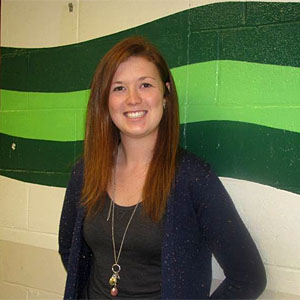A $10,000 Nova Scotia Research and Innovation Graduate Scholarship has helped Carolyn Wilson begin her graduate research thesis. The –¬ľ”∆¬ŃýļŌ≤ Ņ™ĹĪ÷Ī≤•Őż Faculty of Agriculture student plans to determine the effect on soil quality when composts from different sources and varying lignin content are applied.
Őż
She is particularly interested in soil physical properties and the marketable yield of potatoes.
The research focus for her MSc. degree is about the ability of compost to improve the soil’s physical properties: its density, compaction, structure and water retention.
Őż
 Carolyn believes, ‚ÄúCompost application will reduce compaction of the soil. Less compacted soils are easier for roots to penetrate and tubers to grow. So, in this way, compost may increase yield.‚ÄĚ
Carolyn believes, ‚ÄúCompost application will reduce compaction of the soil. Less compacted soils are easier for roots to penetrate and tubers to grow. So, in this way, compost may increase yield.‚ÄĚ
Őż
It is thought that applying compost can reduce plant diseases, howeverŐżCarolyn observes when compost is sterilized (heated to kill micro-organisms) it often loses its ability to reduce disease.
Őż
‚ÄúTherefore, it is proposed that certain organisms, or communities of organisms, are able to reduce disease causing pathogens in the soil, by either competing with them for resources, or directly harming them, or stimulating the host plant to develop some kind of resistance to pests.‚ÄĚ
Őż
Compost will improve soil quality making it more friable and less compacted. “It also increases pores which allow more water and air to be retained within the soil.
Őż
‚ÄúWhat is interesting in my study is if different types of compost will increase soil quality to a greater extent than other types.‚ÄĚ
Introducing a range of composts
The graduate student will also examine aggregate stability in composted soils that occurs when groups of particles bind together more strongly than adjacent soil particles.
Őż
‚ÄúIt is important, because when soil is disrupted by wind or rain, soil with higher aggregate stability tends to resist erosion better and maintain structure.‚ÄĚ
Őż
Aggregates also contribute to a range in soil pore space that is important for the infiltration and holding of water, air and soil biota,ŐżCarolyn explains.
Őż
For her research, she chose a range of commercially available composts from New Brunswick and Nova Scotia, but found there were not very many consistent commercial types of compost available in the region. Also, the waste used for composts varied greatly, particularly in the amount of high lignin content wood products.
Őż
Wilson thought choosing a range of composts, each with different lignin content, would provide an interesting spectrum for her research. ‚ÄúThese composts varied in acidity, nutrient content, organic matter content. They had different size particles and color, along with several other properties.‚ÄĚ
Őż
One compost came from household wastes; two others from two poultry manure sources; the fourth originated from marine (shellfish) waste and the fifth compost was derived from forestry byproducts.
A love of farming
CarolynŐżestablished her compost application site in Fredericton, N.B. this year and will monitor it through 2015 along with a repeat compost application next fall.
Őż
She believes compost application is important because soils cropped repeatedly for potatoes suffer erosion and compaction. This results in a loss of soil organic matter and ultimately soil productivity.
Őż
‚ÄúI love farming and I strongly believe in supporting Maritime agriculture. I am excited about my research because it may help improve local soils and increase productivity. It may also find a valuable use for waste materials.‚ÄĚ
Őż
CarolynŐżgrew up on her family‚Äôs 300-acre farm near Rexton, N.B. where her father raised beef cattle and her grandmother raised Dorset sheep. ‚ÄúIt was truly a family enterprise: I shovelled manure, moved cattle, washed sheep for show and raked hay.‚ÄĚ
Őż
She earned two undergraduate degrees at the University of New Brunswick in Biochemistry and Education. She arrived at the Dal campus in September to work for her MSc. in Agriculture and was ‚Äúpleasantly surprised‚ÄĚ to receive the graduate scholarship. ‚ÄúIt makes things easier. It frees up more time to look at being involved in clubs or organizations.‚ÄĚ
(Reprinted with permission)

